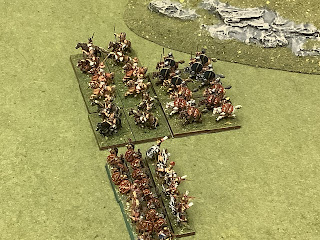Republic To Empire vs General de Brigade
Today’s comparison is a tough one. I’m a fan of both systems, for different reasons. They both share a common figure ratio (20:1) and both originated in the UK. Republic To Empire was originally written for a 28mm scale, but can be easily modified for smaller figure scales.
1. Table appearance (do the unit sizes and organization look like a battle? Both systems utilize a 20:1 scale with detached Skirmisher bases. Guns are scaled as 2 tubes per model base. Both look great on the table with nice, beefy units. A total Draw here.
2. Command and Control (Is C/C challenging and realistic?) General de Brigade utilizes an easy and straight-forward method of changing orders. It is very effective and a streamlined portion of the rules. Republic To Empire actually sports one of the most interesting command /control mechanisms I’ve ever seen. Command points are rolled for based on commander rating. Individual brigade orders are tied to the brigade commander quality and have varying command point costs every turn. To maintain an order, these points must be used first, then orders may be changed with left-over points. Finally, if a unit executes an action apart or different from the rest of the brigade, it must be paid for. In addition, charges must be paid for at the end of the turn. It sounds a bit complicated, but works very well. A tremendous amount of thought must go into the command phase. Although General de Brigade’s system is smooth and effective, I have to give the edge to Republic To Empire. It is refreshingly different !
3. Flow of the turn (Is it clunky or smoothly elegant?) Both rules are similar in that they are tactically gritty with multiple morale checks for units throughout the turn. Charges are similar mechanically. I do think General de Brigade has a bit smoother flow to it, so GdB has a slight edge.
4. Mechanics (Are the mechanics easy to pick up? Do the mechanics have enough detail? Do the mechanics slow the battle down?)
Both systems are tactical games with a lot of detail. Both rules can bog down in detail amid frequent rules look-ups. It’s a Draw here. Those who are drawn to grit and detail will love both systems.
5. Historic results (Do the results seem realistic? Are there wild swings of outcomes?) Both rules pride themselves on realism. General de Brigade typically uses a 2d6 system for firing and melee, while Republic To Empire uses more of a bucket approach which is modified by the tactical situation. It is much more effective than, say, Black Powder’s bucket approach. Both systems work well with how they approach results. Another Draw…..huh oh, I’m seeing a pattern here.
6. Historic tactics (Do historic tactics work? Does the system reward the use of historic tactics?) Since both systems feature very detailed tactics, abstraction of anything is hard to find anywhere. Even massed columns possibly colliding are covered in General de Brigade. I have to say that both systems excel in this area. Yet another Draw.
7. Morale (Does morale feel right on the unit or brigade/divisional level?) Both systems feature multiple morale checks on a unit level. General de Brigade does go a bit further with Brigade morale checks. Players who hate multiple dice rolls for one result will be frustrated by both systems, as no “morale” stone is left unturned. General de Brigade is a bit smoother and less clunky in this area, so gets a slight nod.
8. Playability (Do the rules provide for a fun game, or is it mired in too much detail, etc) If you like tactical games, you will love both systems. General de Brigade is a bit more straight-forward, and Republic To Empire takes a little longer to master, but frankly both rules are exceptionally playable. Another Draw.
9. Ease of setup (what does pre-scenario work look like? Is figure basing too specific? Do the rules require very specific basing?) As for pre-game preparation, both rules are similar. General de Brigade though, is much less flexible in the area of basing. Skirmish companies must be accounted for in the unit by figure. To be honest, it’s a bit frustrating with any collection that may be based for other rules. Republic To Empire is definitely more flexible in this area and gets the win.
10. End of battle (Do the rules give results that can be useful if conducting a campaign? Are Victory objectives taken account? Is Victory defined by the rules?) Victory objectives are scenario specific and must be planned for. Both rules are not meant for tournament play, although General de Brigade does have a detailed points system and terrain placement system for pick up games. Neither system has a post-battle system for use in campaigns, so house rules are required. I would give this area a close Draw for both.
In summary, each system wins in two areas, and result in Draws for every other area. I know, not fair ! I honestly can’t commit either way. Republic To Empire’s command and control system is incredibly cool, but General de Brigade is smooth, elegant, tried and true. Both are very similar when it comes to scale, mechanics, and playability. I guess my advice is…….play both !






































